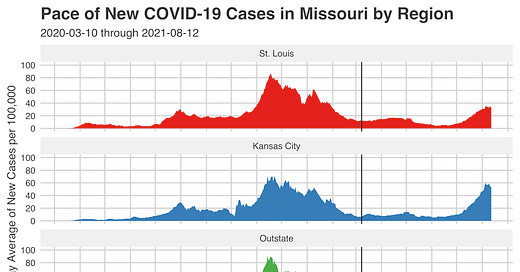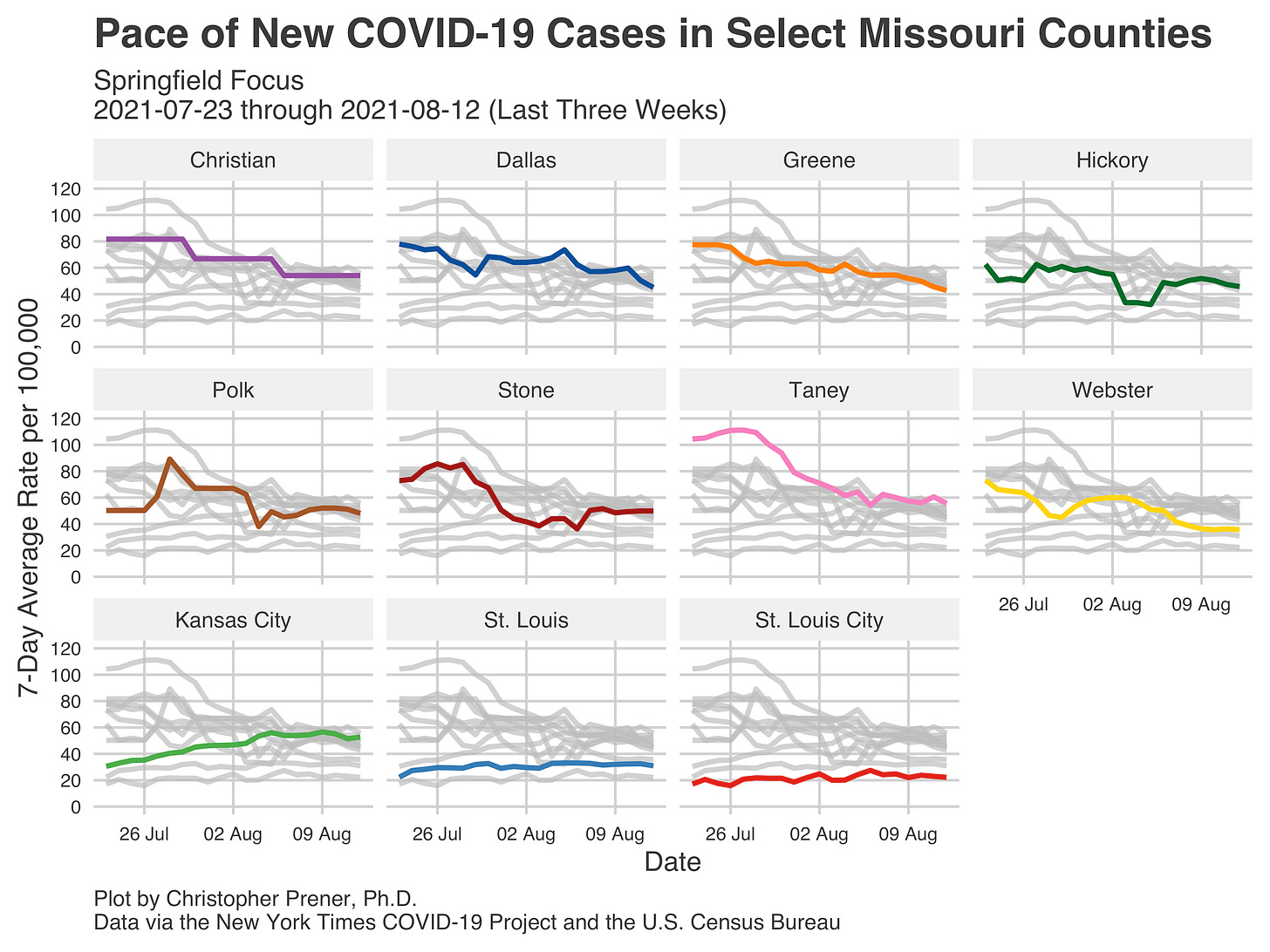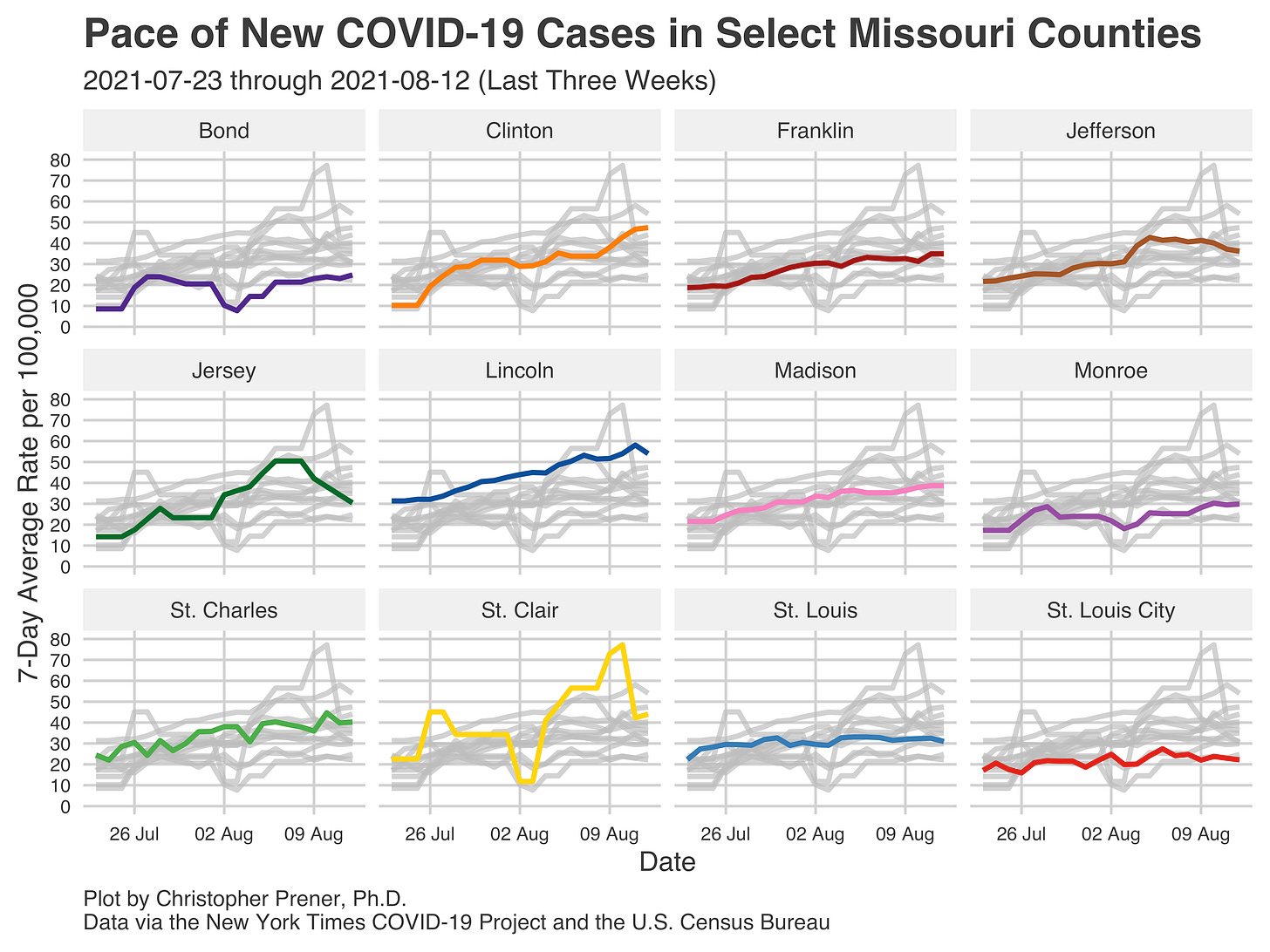I apologize for missing last night’s newsletter - I got some big news and was celebrating! Thanks for your patience. The number of changes this week in our COVID picture are fewer than we have seen in the past couple of weeks, which is a welcome relief. I break these changes down and also highlight two recent media reports about the deliberate undercounting of deaths by state and local officials in Missouri. - Chris
COVID-19 by the Numbers
Total cases in MO: 729,404 (+19,210 from last Friday)
7-day average of new cases per day in MO: 2,744.29 (-227.43 from last Friday)
Counties with the highest per capita rates (per 100,000) of new cases per day this past week:
Dent (118.86 per 100,000), Marion (97.66), Ralls (89.49), Sullivan (88.2), Carter (82.99), Grundy (79.69), McDonald (77.6), and Miller (76.99)
Total deaths in MO: 10,661 (+202 from last Friday)
7-day average of new deaths per day in MO: 28.86 (+3.71 from last Friday)
Percent of all Missourians initiating vaccination: at least 45% (+1% point from last Thursday)
Percent of all Missourians completing vaccination: at least 38% (no change from last Thursday)
Case and mortality numbers are current as of Thursday, August 12th. Vaccination numbers are current as of Friday, August 13th. Additional statistics, maps, and plots are available on my COVID-19 tracking site.
Illness Trends in the Past Week
We are in the midst of what I have been characterizing as an “ebb” in cases. Per capita rates of new cases across Missouri have been fairly stable this week and just below their highs of prior weeks. I had suggested last week that Kansas City may come near its all-time high mark for new cases, but that did not come to pass (or, at any rate, has not yet come to pass). The best news so far, beyond this general ebb, is that rates in St. Louis remain well below their prior highs.
The picture in “outstate” Missouri is far more complicated. There is a shifting process unfolding right now that is different from what we saw even last week. Areas that had been very hard hit, including around Springfield, saw their rates slowly fall away. This is an improvement, certainly, but those rates of new cases are still far higher than they were in early May.
At the same time, other areas, such as around Lake of the Ozarks, are seeing their rates remain at stubbornly high levels without the declines in the last couple of weeks that we see to the south and southwest. In Miller County, and more notably in Dent County, we even see cases growing.
Then we have rates climbing in three parts of Missouri in particular, all of which are visible on the map below. First, Southeast Missouri, which had largely avoided spiking case rates, is now seeing growth across the region. Butler and Stoddard counties represent an interesting departure from these increases - rates are falling in ways that are more similar to counties to the west in the Ozarks. In both counties, however, rates remain quite high.
The other two areas seeing increases right now are in Northeastern Missouri, centered on Marion County (where Hannibal is located), and rural counties to the east and southeast of Kansas City. The cluster of counties in Northeastern MO has a corresponding cluster to the east in Illinois.
What these trends mean is that outstate Missouri’s overall rate of new cases remains flat. This obscures, however, the expansion of new cases in some areas while they slowly fall in others. The good news is that these are happening in tandem, instead of cases expanding in new areas at higher rates than they fall elsewhere.
I want to briefly touch on what is happening in St. Louis as well. You can see on the map that St. Louis City and County are both among the lowest rates of new cases right now in Missouri. These rates stabilized before other counties in the region and at lower rates. You have to wonder what role the mask mandate in the City and the very short-lived requirement in the County have played in this.
Despite these flat rates of new cases, hospitalizations in St. Louis continue to rise steeply. Rates of new patients admitted each day have now outstripped the pace at which this was occurring during the first wave of the virus, and rates of patients in ICU are growing at similarly steep rates.
Rates of mortality have also climbed. The St. Louis Pandemic Task Force reported twenty-five deaths in the past two days, and we are seeing our lagged mortality trend climbing as well. It will likely never compare to the sheer volume of death we experienced in the fall and winter, but I anticipate that it will continue to grow into September.
One of the reasons I anticipate that these rates will continue to climb is the highs we have seen in hospitalizations in in-patient rates in Jefferson City, Joplin, and Springfield. In all three metropolitan areas, these rates peaked at the end of July at their highest rates of the pandemic.
In the Spring of 2020, our rallying cry was to “flatten the curve” in part to save our hospital systems from collapse. We need to remember that need now, as medical providers in Missouri and around the American South are experiencing incredible pressure.
Vaccination Trends in the Past Week
Vaccinations continue to be occurring at relatively high rates across Southern Missouri. I have said before, however, that this is welcome but insufficient because it is occurring after we have seen a mass wave of new cases and hospitalizations that, in some cases, are worse than what we have experienced at any point prior in the pandemic. However, these vaccinations will help us blunt a possible additional surge in the fall, even if they are too late to help us immediately.
Into the Weeds
There are two important articles to check out related to COVID deaths in Missouri. The first, in the Kansas City Star, discusses the manipulation of COVID statistics where at least local coroner (who are elected officials in Missouri) has left COVID off death certificates.
The second is out today in the Missouri Independent, highlighting the failure of Missouri’s state officials to report the total number of deaths accurately. My data (which you can see summarized above) suggest that 10,661 deaths have been reported, while Missouri only acknowledges just over 10,000. The Independent Rudi Keller, who bravely visits every Missouri local health department website or Facebook page regularly, believes that there are at least 500 more deaths - at least 11,182.
We must understand the full toll of COVID in our state. But, unfortunately, both reports suggest that Missouri’s government, at both the state and local levels, is deliberately standing in the way of that goal.
If you like what you see here and don’t already, please subscribe!











